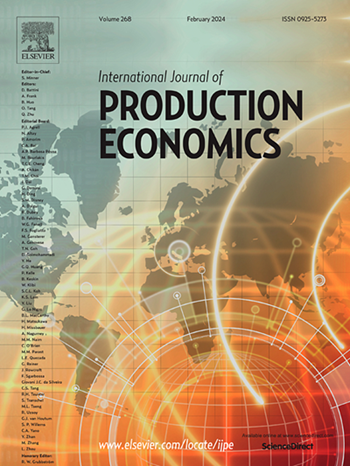Dynamic analysis of the proportional order-up-to policy with damped trend forecasts
IF 10
1区 工程技术
Q1 ENGINEERING, INDUSTRIAL
引用次数: 0
Abstract
We study the bullwhip behaviour in the proportional order-up-to (POUT) policy with non-stationary autoregressive integrated moving average (ARIMA) demand. We build a state-space model of the POUT policy where the damped trend forecasting method predicts ARIMA(1,1,2) demand. The POUT policy is closely related to the order-to-up (OUT) policy with the addition of a proportional feedback controller in the inventory and work-in-progress feedback loops. Our modelling approach allows us to derive and/or analyse the demand, order, and inventory variances. We also find the covariance between the demand forecast and the inventory forecast in an attempt to obtain the order variance. However, both the demand and the order variances are infinite under the non-stationary ARIMA(1,1,2) process. Thus, the traditional bullwhip measure (the ratio of the order variance divided by the demand variance) is indeterminate. Despite this difficulty, we can study the difference between the order variance and the demand variance for both the OUT and POUT policies. These differences are finite and their sign indicates whether a bullwhip effect has been generated or not. We find under non-stationary demand, the POUT policy’s bullwhip behaviour contradicts some of the existing bullwhip theory. The POUT policy sometimes generates more bullwhip than the OUT policy, revealing that existing knowledge based on stationary demand should be used with caution in non-stationary demand environments. We validate our findings with an investigation of some ARIMA(1,1,2) time series from the M4 competition.
带阻尼趋势预测的比例序向上策略的动态分析
本文研究了具有非平稳自回归积分移动平均需求的比例自阶向上(POUT)策略下的牛鞭行为。我们建立了POUT策略的状态空间模型,其中阻尼趋势预测方法预测了ARIMA(1,1,2)需求。POUT策略与订货到货(order-to-up, OUT)策略密切相关,在库存和在制品反馈循环中添加了一个比例反馈控制器。我们的建模方法允许我们推导和/或分析需求、订单和库存差异。我们也发现了需求预测和库存预测之间的协方差,试图得到订单方差。然而,在非平稳ARIMA(1,1,2)过程下,需求和阶数方差都是无限的。因此,传统的牛鞭度量(订单方差除以需求方差的比率)是不确定的。尽管存在这个困难,我们仍然可以研究OUT和POUT策略的订单方差和需求方差之间的差异。这些差异是有限的,它们的符号表明是否产生了牛鞭效应。我们发现在非平稳需求下,POUT政策的牛鞭行为与现有的一些牛鞭理论相矛盾。POUT策略有时比OUT策略产生更多的牛鞭,这表明在非平稳需求环境中应谨慎使用基于平稳需求的现有知识。我们通过调查一些来自M4比赛的ARIMA(1,1,2)时间序列来验证我们的发现。
本文章由计算机程序翻译,如有差异,请以英文原文为准。
求助全文
约1分钟内获得全文
求助全文
来源期刊
CiteScore
21.40
自引率
7.50%
发文量
266
审稿时长
52 days
期刊介绍:
The International Journal of Production Economics focuses on the interface between engineering and management. It covers all aspects of manufacturing and process industries, as well as production in general. The journal is interdisciplinary, considering activities throughout the product life cycle and material flow cycle. It aims to disseminate knowledge for improving industrial practice and strengthening the theoretical base for decision making. The journal serves as a forum for exchanging ideas and presenting new developments in theory and application, combining academic standards with practical value for industrial applications.

 求助内容:
求助内容: 应助结果提醒方式:
应助结果提醒方式:


